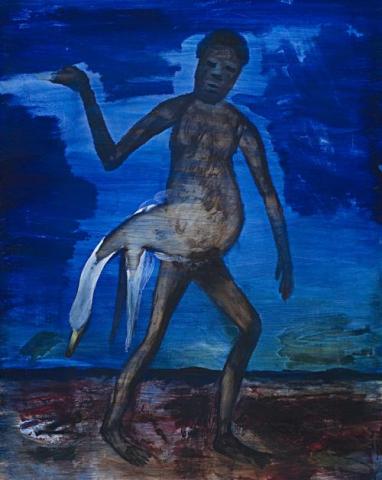LEDA AND SWAN, c.1960
Sidney Nolan
polyvinyl acetate on composition board
152.0 x 122.0 cm
Lord McAlpine of West Green
Sotheby's, Melbourne, 26 November 2002, lot 59
Private collection, Melbourne
The ancient greek myth of Leda and her swan exists in several versions. In its simplest form, the god Zeus transforms himself into a swan and couples with the Aeolian princess, wife of the King of Sparta. She subsequently lays an egg from which hatch Polydeuces and Helen of Troy. The divine visitation - which culminated of course in the Trojan War - has been a powerful image through the ages. Nolan, however, was scarcely interested in the story; and owes nothing to versions by Leonardo, Michelangelo, Tintoretto, Correggio etc. Indeed, his stimulus was essentially poetry rather than painted imagery.
Nolan was first inspired by the theme in 1945; perhaps after reading Rilke's Leda, which focuses more on the god's assumption of majestic new power than on the woman's response' In 1958, when Nolan was living in New York, the trigger which again fired his imagination was an unpublished poem by a little-known Australian, Alwyn Lee, ending - 'Until black Jupiter with snake-like head,/ Has taken lubra Leda to her bed,/ And everything, including tears, are shed.' As he read these lines the myth came alive and he started to paint. 'I found my mind full of images and necks and wings' he says. His memory mingled images of swans in London; coloured lights reflected on the River Thames at Putney; the body of his stepdaughter swimming underwater; landscapes of Arizona; a decrepit poor white village; the Pacific seabed.'1
As Rosenthal further notes, 'The sheer number of paintings he produced on this theme have enabled him, insofar as a myth can ever be definitive, to produce an almost exhaustive visual exploration of the subject. The attitudes of the two figures in the background are of an almost infinite variety. Sometimes Leda and the Swan are shown apart; at other times their figures combine in every conceivable joint posture and involvement, covering all the permutations of puzzlement, love, lust, tenderness and aggression. Sometimes the pair merge with each other, as if taking on the other's identity. Sometimes they are seen in a dream-like limbo; sometimes they are half hidden in a heavy luscious jungle, at others in a typical Nolan desert which brings at least hints of earlier Australian paintings.'
The Leda pictures contain a wonderful interplay of land and sea, mountains and clouds, wild vegetation and almost reckless use of colour which combine to produce some of the most sensually exciting works in his oeuvre. The bulk of the large paintings shown at Matthiesen in 1960 were sold within two days at between £15,000 and £20,000 'He was critically acclaimed, socially something of a lion and financially very successful. Looking at the Leda series, it is impossible to deny him the justice of this triumph- the best, by which he should surely be judged, are great and timeless works of art, and show the growth not only of is technical skill but also of his intellectual versatility and his imaginative power.'2
1. Clark, J., Sidney Nolan: Landscapes and Legends, A Retrospective Exhibition, Cambridge University Press, Melbourne, 1987, pp. 132-33
2. Rosenthal, T.G., Sidney Nolan, Thames and Hudson, London, 2002, pp. 151-53
